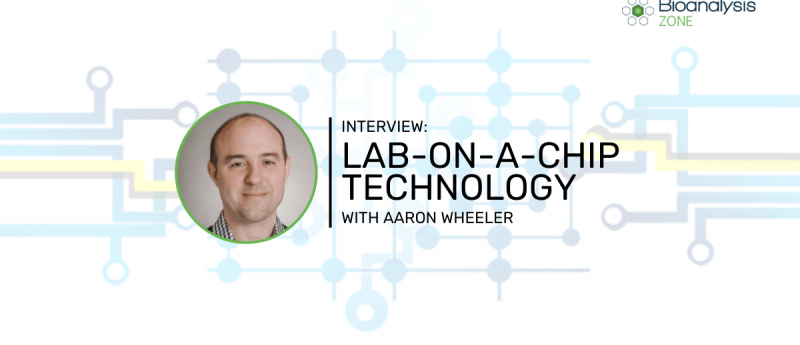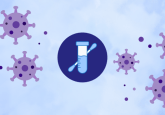The age of lab-on-a-chip technology is now – an interview with Aaron Wheeler

As part of our feature examining lab-on-a-chip technology, we interviewed lab-on-a-chip expert, Aaron Wheeler from the University of Toronto (Canada). Aaron described his experience and research in the field and explained to us that the age of lab-on-a-chip is well and truly upon us.
1 Could you please begin by introducing yourself, your research background and current research focus?
My name is Aaron Wheeler. Since 2005, I have been a faculty-member at the University of Toronto, in Canada. Prior to that I was a postdoctoral fellow at University of California, Los Angeles (CA, USA) from 2003–2005 and prior to that I was a graduate student at Stanford University (CA, USA) from 1997–2003. My lab at the University of Toronto develops microfluidic solutions to problems in chemistry, biology and medicine. Since 2013 I have been an Associate Editor for the flagship journal in this discipline, Lab on a Chip. I have loved this job, as it has kept me engaged with the incredible diversity and creativity in the microfluidics community. Years ago, when I joined the community, we all wondered what microfluidics could do. Now when I think about the creative work that I see, I wonder what it can not do – whether you study cells or gels, soil or oil, trees or bees, there is a lab-on-a-chip for that. I can’t imagine a community that is more fun to be a part of.
2 Could you describe your experience with lab-on-a-chip technology: how did you get involved in the field and how does it feature in your current research?
“…when deployed wisely, microfluidics brings sophisticated analytical capabilities to the end-user, often in a form-factor that is amenable to use in settings that are out of reach for other techniques.”
I am an analytical chemist and I began my PhD with Prof. Dick Zare at Stanford with an interest in developing sensitive techniques to measure tiny amounts of analytes in biological systems. Soon after I joined the group, a new postdoc in the lab, Dr Keisuke Morishima, introduced us to the (then very new technique of) ‘microfluidics.’ I began working with the technology then and have been hooked on it ever since. As with any interesting technique, it has been over-hyped at times and it is certainly not a panacea that can solve all problems, everywhere, all the time. But when deployed wisely, microfluidics brings sophisticated analytical capabilities to the end-user, often in a form-factor that is amenable to use in settings that are out of reach for other techniques. My research group in Toronto and I enjoy thinking about the ‘portability’ aspects of microfluidics, and have explored using lab-on-a-chip devices in settings ranging from a remote refugee camp in northwest Kenya (e.g., see our paper or a short movie describing this subject) to inside the (tiny) bore of a superconducting magnet in an NMR spectrometer. We have many other eclectic interests, as well – the great thing about being in academia is the freedom to explore.
3 Lab-on-a-chip technology offers many potential benefits, ranging from accessible point-of-care diagnostic applications to reduced reaction times and decreased reagent cost and chemical waste. What do you think are the main benefits it could bring to your research?
The advantages that you list are often used to try to ’sell’ microfluidics – for example, I often see them (and have written them) in the introductions to journal articles. I agree with them all, and might add some others to the list, but more importantly – I think that what we ‘say’ about the technology is less important as the technology matures. If it really is ‘useful,’ it will be ‘used’ – this is the most important metric to consider. Taking that argument further, I propose that we researchers should stop spending so much time ‘selling’ the technology and instead spend time demonstrating its utility to the end-user (note that I include myself as being someone who can benefit from hearing this message).
4 In 1991, Andreas Manz et al asked whether miniaturization of chemical analysis systems was ‘a look into next century’s technology or just a fashionable craze?‘ Almost 30 years on, we’ve seen many developments in the field. What challenges have been overcome and what are the remaining challenges to address?
I love Andreas and that’s a great quote – he and a handful of others (including Canadian Jed Harrison) opened the door to a new field of research, and more importantly, had the audacity to dream about how that field might grow to impact society in years to come. His vision has been a beacon and a rallying point for the community and continues to inspire to this day. As for ‘crazes,’ I agree that there have been some ‘faddish’ moments in microfluidics, and our community is not immune to getting stuck in ruts of ‘group-think’ and ‘follow-the-leader.’ But to a large extent, I think we have weathered those periods and I have never been more excited about the growing list of problems that microfluidics is helping (and will continue to help) to solve. You ask about challenges – the list is never-ending, which is good for researchers of all stripes! For example, many of us are thinking a lot about ‘autonomy’ and ‘distribution’ these days, moving from ‘one researcher loading a sample into one device for analysis’ to a ‘network of devices that collect their own samples, analyze them and report the results back to the researcher’ in real time. This type of vision can only be realized with vast input from creative engineers, chemists, physicists, end-users and the like. Exciting times!
5 What do you think the future could hold for lab-on-a-chip technology? Will it become a widespread commercial success?
There has been a fair amount of hand-wringing over the years about the need for a ’killer app’ for microfluidics and there are likely those who still worry about whether it will become a ‘widespread commercial success.’ I understand that commercial success has taken some time, but I think those worries are misplaced – the brave new (microfluidic) world is upon us! Look at how life science is being transformed by the Bio-Rad ddPCR system and what 10x Genomics is doing – or remember the many long-term successes like the venerable Abbott i-STAT system or the Cepheid GeneXpert products. I predict that as time goes on, microfluidic products will become so ubiquitous that this type of question will seem sillier and sillier… perhaps akin to being in the 1960s and wondering about whether this ‘integrated transistor thing’ is going to catch on, or being in the 1990s and pondering whether a ’web of connected computers’ is going to impact our daily lives.
Bottom line – for better or for worse, microfluidics is here and it is here to stay.
Disclaimer
The opinions expressed in this interview are those of the interviewee and do not necessarily reflect the views of Bioanalysis Zone or Future Science Group.






